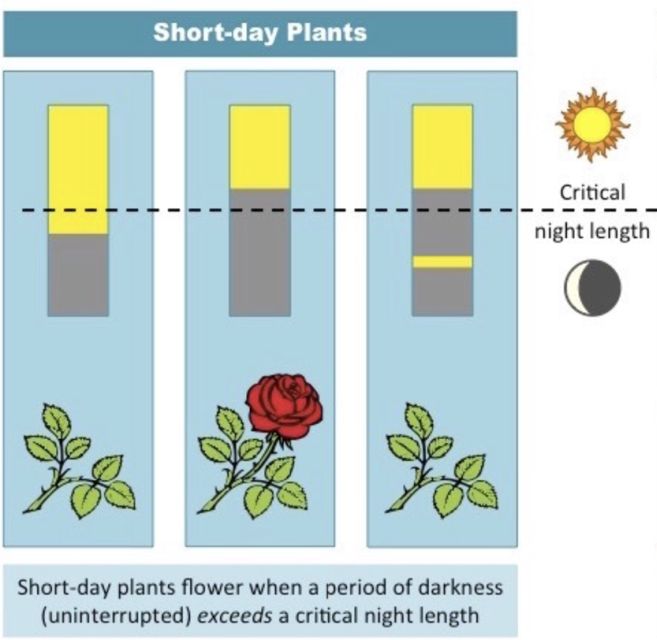Maximizing the Beauty and Productivity of Short-Day Plants
While poinsettias are typically associated with Christmas, they can be found blooming in nature during the month of December. This is because they require exposure to shorter days and longer nights to bloom. Today, most poinsettias sold in the U.S. are grown in greenhouses with light deprivation so that they will be ready for sale a month earlier than if they were left to grow naturally.
Many people new to controlled environment agriculture associate light deprivation with cannabis as it is a common technique used by growers to induce flowering in cannabis plants. By modifying the lighting schedule from an 18-hour photoperiod to a 12-hour one, growers can trigger their plants to enter the flowering stage. Greenhouse growers who are cultivating cannabis year-round may use light dep curtains and light traps on their fans and vents to block sunlight for a few hours in the morning or evening, especially in the summer when daylengths are longest. This technique can be used to great effect to produce high-quality buds.
As the days grow shorter in autumn and winter, many plants naturally enter into their reproductive stage. These plants are short-day (SD) plants and include poinsettias, cannabis, Christmas cactus, chrysanthemums, and asters. When daylengths are long, these plants will remain vegetative, happily growing leaves and stems. As the days get shorter, however, these plants start to transition into their reproductive stage, reallocating resources from leaf production to flower production. Over time, as SD plants are continuously exposed to short day lengths, their flowers fervently grow and blossom into the blooms we love. Thus, by changing the amount of light exposure these plants receive on a daily basis, gardeners can manipulate when these plants grow and share their festive blossoms.

Common short-day plants: Poinsettia, Cannabis, Chrysanthemum, Christmas Cactus; Photo: Nadia Sabeh
For SD plants, flowering is signaled when they sense decreasing levels of red (R) light and increasing levels of far red (FR) light. Sunlight has a lot of R light and a little FR light. As daylengths shorten, plants are exposed to less R light, until eventually the FR light exceeds R light. When the ratio of FR/R is greater than 1, SD plants produce less of the protein (phytochrome, Pfr) that inhibits flowering and they switch from vegetative to reproductive mode.
To ensure your SD plants flower when you want them to, it’s important to give them a period of uninterrupted darkness – thus, becoming your “long night” plants. This means keeping them in a dark room or closet so that they remain in flowering mode. If these plants are exposed to photosynthetically active radiation (PAR), especially red light, during the dark period, they will stop flowering. For female cannabis plants, not only will they stop flowering, but they will also become hermaphroditic and produce seeds.

Figure 2. The effect of night length on Short Day, flowering plants. If the critical night length is not achieved or is disrupted with light, Short Day plants won’t flower. Image courtesy of BioNinja (https://ib.bioninja.com.au/higher-level/topic-9-plant-biology/untitled-3/photoperiodism.html).
Every SD plant has a critical night length that triggers flowering. For poinsettias, flowering is triggered when night lengths are greater than 11 hours, 45 minutes. For cannabis, although most growers target 12 continuous hours of darkness, peer-reviewed research out of Australia has shown night lengths of 10 hours will do the trick for most cultivars, which is why they start blooming naturally in the Fall rather than Winter, like poinsettias. For many plants, if the critical threshold is exceeded, they will flower more quickly. Therefore, for greenhouse and outdoor cannabis growers, it may not be necessary to light dep for 12 hours, but that longer dark period could make them transition more quickly to flower. Similarly for indoor cannabis growers, extending the dark period for longer than 12 hours could induce faster flowering.
Higher temperatures during the dark period have also been shown to speed up flowering for certain short-day plants. For poinsettias, it has also been shown that as long as they have been continuously exposed to long nights for a certain number of weeks, they will continue to flower if exposed to longer days. That’s why they continue to flourish in brightly lit stores, enticing us to buy them.
Cannabis growers are always looking for ways to increase yields and maximize profits. One potential way to do this is by managing the dark period – the time when plants are not exposed to light.
While there is no definitive research on how this practice would affect indoor cannabis flower production, based on research for other horticultural crops, it is possible that extending the dark period and targeting higher temperatures could result in plants that produce bigger flowers, leading to more harvest cycles and greater annual revenue. Additionally, extending the dark period could reduce energy costs associated with lighting, cooling, and dehumidification. By simultaneously increasing revenue and reducing costs, cultivators of short-day crops, such as cannabis, could catapult net profits and decrease the demand for energy. However, more research is needed to confirm whether this practice will have a net benefit.
To learn more about the history of poinsettias, check out this article.









